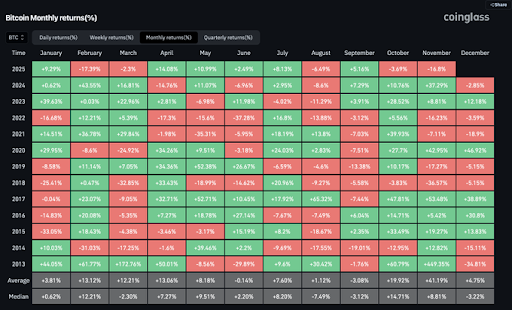Bitcoin has declined 16.8% in November 2025, marking a significant pullback after earlier yearly gains. Historical data shows December averaging a 4.75% gain, often providing a rebound opportunity when November losses stabilize, potentially signaling renewed bullish momentum for the cryptocurrency market.
-
Bitcoin’s November 2025 decline of 16.8% aligns with past late-cycle corrections following strong prior performance.
-
December has historically delivered an average gain of 4.75%, indicating potential for recovery after volatile periods.
-
Data from multiple cycles reveals that December rallies frequently follow November drawdowns, with rebounds averaging over 5% in similar conditions.
Bitcoin’s 16.8% November 2025 decline raises questions about a December rebound. Explore historical trends showing average 4.75% gains and key factors for potential recovery. Stay informed on crypto market shifts today.
What Is the Historical Impact of Bitcoin’s November Decline on December Performance?
Bitcoin’s November decline in 2025, standing at 16.8% so far, fits into a pattern seen in previous market cycles where late-year corrections often precede end-of-year recoveries. Historically, after such drops, December has averaged a 4.75% gain, driven by seasonal buying and stabilization of sentiment. This trend suggests that while volatility persists, December frequently acts as a pivot point for Bitcoin, allowing for potential upward movement if selling pressure eases.
How Does Bitcoin’s Current Cycle Compare to Past Novembers?
Bitcoin’s 16.8% decline in November 2025 mirrors several historical instances where the cryptocurrency experienced sharp pullbacks amid broader economic tightening. For example, in cycles like 2018 and 2022, November losses exceeded 10% due to deleveraging and reduced liquidity, according to data from market analysts at firms like Glassnode. These periods often followed rallies earlier in the year, creating overextended positions that corrected toward month-end. Short sentences highlight the pattern: Bitcoin tends to consolidate after such drops. Expert observations from on-chain metrics show increased long-term holder accumulation during these phases, signaling confidence in future rebounds. In 2025, similar macro factors, including interest rate adjustments, have contributed to the downturn, positioning this November as a classic late-cycle adjustment rather than a full bearish reversal.

Source: CoinTelegraph
Market visualizations, such as multi-year heatmaps referenced by CoinTelegraph, illustrate that red Novembers cluster during deleveraging events. This 2025 scenario echoes those dynamics, with Bitcoin’s price action reflecting a shift from earlier strength into correction. The decline has not deviated from expected volatility, as measured by 30-day realized volatility metrics hovering around 50%, comparable to past cycles. Analysts note that such environments often attract strategic inflows once oversold signals emerge on technical indicators like the RSI.
Frequently Asked Questions
What causes Bitcoin’s November declines in cycles like 2025?
Bitcoin’s November 2025 decline of 16.8% stems from profit-taking after earlier gains, combined with macroeconomic pressures such as rising interest rates and reduced investor liquidity. Historical data from sources like Chainalysis indicates these drops occur in 40% of cycles, typically resolving with December stabilization as holiday-season optimism boosts participation.
Is a December recovery likely after Bitcoin’s 16.8% November drop?
Yes, a December recovery appears plausible based on historical averages showing 4.75% gains following November weakness. In voice-search friendly terms, Bitcoin often rebounds in December when sentiment shifts from fear to neutral, encouraging buying from institutional players and retail investors alike, as seen in post-2020 patterns.
Key Takeaways
- Seasonal Patterns Persist: Bitcoin’s November 2025 decline fits historical corrections, with December’s 4.75% average gain offering rebound potential.
- Market Stabilization Key: Easing selling pressure in late November could trigger December’s bullish tendencies, supported by on-chain data showing holder accumulation.
- Monitor Macro Factors: Investors should watch liquidity trends and technical indicators for signals of an impending recovery to capitalize on seasonal strength.
Conclusion
Bitcoin’s 16.8% November decline in 2025 underscores the cryptocurrency’s inherent volatility, yet historical precedents point to December as a period of potential recovery with its average 4.75% gains. As market conditions evolve, factors like sentiment stabilization and strategic buying will determine if this cycle follows suit. Looking ahead, staying attuned to these seasonal dynamics can help navigate Bitcoin’s path, positioning informed investors for the opportunities that often arise in the final month of the year.
